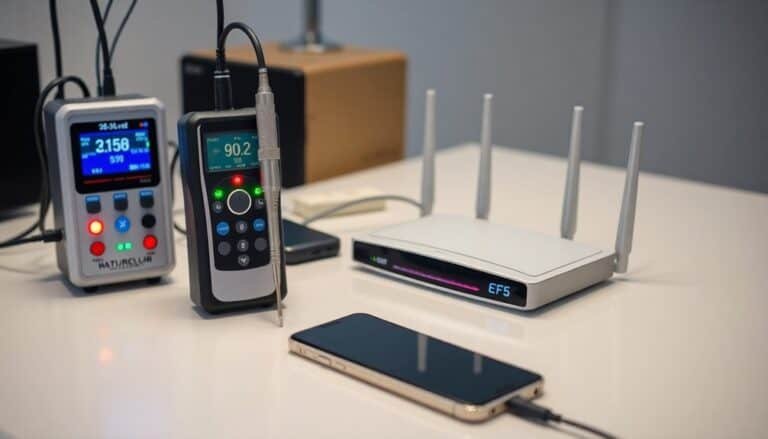Sun Exposure Vs EMF Exposure: Contextual Safety
Daily exposure to UV radiation from the sun boosts vitamin D, enhancing mood and bone health, but too much can lead to skin cancer and aging. Similarly, EMFs from devices may cause oxidative stress, affecting cellular functions.
To protect yourself, use sunscreen and UPF clothing for UV exposure, and maintain a safe distance from devices to reduce EMF exposure. Explore specific protection methods and emerging technologies for better safety.
Disclaimer: As an affiliate, I may collect a share of sales from the links on this page.
Health Benefits of Sun Exposure

Sunlight boosts your vitamin D levels, which is essential for bone health and immune function. It improves mood, reducing symptoms of depression, and enhances physical performance by optimizing muscle function. Additionally, vitamin D production through sun exposure plays a crucial role in regulating calcium and phosphorus metabolism, further supporting overall health. Sunlight also supports cardiovascular health, linked to a reduced risk of cardiovascular diseases. Additionally, exposure to sunlight helps regulate sleep patterns, impacting your circadian rhythms. Moderate sun exposure may also lower the risk of certain cancers, Alzheimer’s disease, and diabetes complications, demonstrating a multifaceted positive influence on your overall well-being.
Risks Associated With UV Radiation
Although sun exposure has health benefits, it also presents significant risks, particularly due to UV radiation. Excessive exposure can lead to about 1.2 million new cases of non-melanoma skin cancers and 325,000 melanomas annually. Additionally, it contributes to approximately 64,000 premature deaths due to non-melanoma skin cancers and 57,000 from melanoma each year. Vulnerable groups, like children and outdoor workers, are at an increased risk. Fair-skinned individuals face a higher chance of sunburn and skin cancer, while individuals with a family history also have increased susceptibility. Excessive sun exposure in children and adolescents increases skin cancer risk later in life. Protect your skin with clothing and sunscreen, especially during peak UV hours.
Understanding EMF Exposure

Electromagnetic fields (EMFs) are present in various environments, stemming from both natural and artificial sources. You can measure EMF exposure using EMF probes, which act as optimized antennas for evaluating electromagnetic fields. These measurements can be broadband or frequency selective, providing details in volts per meter (V/m) for electric fields and amperes per meter (A/m) for magnetic fields. Tri-axial probes capture field components in three directions simultaneously. Isotropic probes simplify measurement by determining total field value without repositioning. Exposure guidelines, like the Radio Frequency Protection Guides (RFPG), set limits to guarantee safety, while specific absorption rate (SAR) gauges energy absorbed by the body, addressing health considerations inherent in EMF exposure. Regular monitoring of EMF levels is essential for assessing environmental safety and ensuring compliance with established guidelines.
Biological Effects of UV and EMF
Understanding the biological effects of UV and EMF exposure is essential for recognizing their impact on human health.
UV radiation can damage DNA, increasing skin cancer risk, including melanoma, and accelerate skin aging. It also harms the eyes, leading to conditions like cataracts.
EMF exposure triggers oxidative stress, potentially altering cellular function and leading to cognitive impairment and cardiovascular issues. Research on 5G safety concerns indicates that while 5G does not cause dizziness, some individuals may still experience effects due to heightened sensitivity.
Both UV and EMF can disrupt cell proliferation and cause chromosomal abnormalities. Prolonged exposure to either radiation elevates cancer risks, underlining the importance of understanding these biological mechanisms to inform protective measures and personal safety.
Protective Measures Against UV and EMF

Protective measures against UV and EMF exposure are essential for safeguarding health.
For UV protection, wear UPF-rated clothing, apply broad-spectrum sunscreen with SPF 30+, and seek shade during peak hours. Utilize wide-brimmed hats and UV-blocking sunglasses to protect your face and eyes.
For EMF exposure, maintain distance from devices, utilize copper or aluminum shields, and limit device usage time. Regularly test for EMF levels to identify high-exposure areas. Additionally, consider using affordable EMF shielding options to enhance your protection against radiation.
Employ EMF-reducing technologies for better safety. Understand and educate yourself on risks, adhere to safety standards, and participate in public awareness efforts for extensive protection.
Impact on Immune System Functionality
Sun exposure and EMF exposure influence immune system functionality through different mechanisms, each presenting unique health implications.
Sunlight boosts vitamin D production, which is essential for immune regulation. It also activates T-cells, enhancing immune response. Conversely, high UV exposure can suppress immunity, increasing vulnerability to infections.
EMF exposure has less research backing; however, it may induce oxidative stress, potentially harming immune cells. Some studies indicate that EMFs could elevate inflammation levels, negatively affecting immune function.
Therefore, understanding these exposures is vital for managing health risks while benefiting from the positive aspects of sunlight and being cautious about EMF exposure.
Economic Costs of UV and EMF Health Risks
While both UV and EMF exposures pose health risks, their economic implications differ greatly.
UV exposure, primarily linked to skin cancers, incurs substantial healthcare costs, with over 1.2 million non-melanoma cases annually. Preventive measures like sunscreen are affordable, costing about $30 to $62 a year.
In contrast, EMF health risks lack clear economic data, complicating cost assessment. While companies may incur compliance costs and potential litigation, specific figures remain ambiguous.
Public Awareness and Safety Guidelines
To effectively reduce health risks associated with UV and EMF exposure, raising public awareness plays an essential role. Public campaigns inform you about critical safety guidelines, encouraging preventive behaviors.
Educational initiatives focus on the risks of excessive exposure, while media coverage amplifies these messages. Community engagement fosters adherence to safety practices, ensuring messages resonate culturally.
For UV safety, apply sunscreen with SPF 15 or higher, seek shade during peak hours, and wear protective clothing.
For EMF, maintain distance from sources and limit device usage. Understanding these guidelines promotes safer habits and reduces health risks associated with both UV and EMF exposure.
Emerging Technologies for Protection
Emerging technologies are rapidly transforming how you can protect yourself from both EMF and UV radiation.
Advanced EMF shielding materials are projected to reach a $15 billion market by 2025. Innovative products, like mobile phone cases and EMF protection clothing, offer personalized safety solutions.
Enhanced EMF meters, such as the Trifield TF2, detect various radiation types, ensuring effective monitoring.
In addition, integrated protection systems combine UV and EMF defense into one product. Solutions using graphene and nanotechnology improve lightweight shielding.
As health concerns rise, the demand for better protection technologies continues to grow, driving innovations across multiple sectors.
Future Research Directions in UV and EMF Studies
The advancement of protection technologies has sparked significant interest in future research directions for UV and EMF studies.
You’ll find that developing new materials for UV LEDs and EMF shielding could enhance safety. Establishing robust experimental models will help evaluate biological effects.
Statistical analysis will support complex data interpretation. Global databases for UV and EMF research findings will facilitate knowledge sharing.
Meanwhile, risk assessments will evaluate long-term effects. Finally, interdisciplinary collaboration among experts is essential.
Together, these efforts aim to create public health guidelines for safe exposure levels, ensuring ideal protection against the potential risks of both UV and EMF exposure.
Frequently Asked Questions
How Does Sun Exposure Affect Mental Health?
Sun exposure boosts your serotonin levels, improving your mood and overall mental health. It can help combat feelings of fatigue and depression, especially during seasons with less sunlight, enhancing your overall well-being and emotional stability.
Are There Safe Tanning Alternatives Available?
You’ve been searching for the perfect tan without sunburn or skin risks, right? Try spray tanning or self-tanning products! They provide a safe, customizable glow without UV exposure, leaving your skin looking fabulous and healthy.
What Role Does Vitamin D Play in Mood Regulation?
Vitamin D influences your mood by regulating neurotransmitters like serotonin and melatonin. It affects brain structures essential for emotions, and maintaining adequate levels may help you feel more balanced and improve overall well-being.
How Can I Measure My UV Exposure Accurately?
To measure your UV exposure accurately, use radiometrically calibrated spectrometers or UV radiometers. Guarantee they’re regularly calibrated and maintained, and consider environmental factors like cloud cover that might affect the readings you get.
Do Indoor Light Sources Emit Harmful EMF?
Yes, indoor light sources emit EMFs, but most are low-level and not considered harmful. However, you should be mindful of prolonged exposure, especially with certain types like CFLs and dimmable LEDs that produce more emissions.
Conclusion
Both sun and EMF exposure carry health risks. UV exposure is responsible for about 90% of non-melanoma skin cancers, emphasizing the need for protection. While UV primarily causes skin damage and cancer, the long-term effects of EMF exposure remain less understood. Awareness of these risks can guide safety guidelines and protective strategies for managing radiation.






